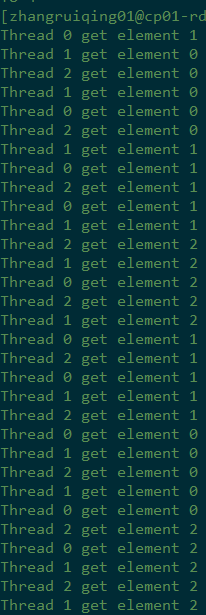- 1网络安全(黑客)技术——自学2024_黑客技术栈 是网络安全?
- 2机器人的自然语言处理:聊天机器人的设计与开发
- 3MongoDB全文检索: 助力快速精准的文本搜索_mongodb 全文检索
- 4【实战】基于springboot2.7x集成ShardingSphere5.X的分表及自定义分片策略配置_shardingsphere 自定义策略
- 5从0到短视频高手:新手必备4种工具,助你制作出精彩短视频
- 6软件测试简历编写技巧,对症下药,一周面10家..._个人优势 软件测试简历
- 7【DevOps】 什么是容器 - 一种全新的软件部署方式_devops容器化是什么
- 8[MIT6.828] LAB4 PART A_extend the env structure to provide a save area fo
- 9JAVA_Set系列集合:HashSet、LinkedHashSet、TreeSet底层详解_set以及hashset,treeset 底层
- 10解决服务器80端口无法连接的办法_服务器80端口无法访问
python多线程threading
赞
踩
本文通过 4个example 介绍python中多线程package —— threading的常用用法, 包括调用多线程, 同步队列类Queue, Ctrl+c结束多线程。
example1.
调用10个线程, 分别打印0~4, 每打印一个数pause一秒钟。
code如下所示, 在test()函数中用threading.Thread建立10个线程;
一种方法是不要将这些线程设置为守护线程,如code所示;
一种方法是设置守护线程( setDeamon(True)),并用join()让程序等所有线程结束了再退出(即去掉code中的注释);
#/*********************************************************************
# *-
# * Copyright (c) 2015 Baidu.com, Inc. All Rights Reserved
# *-
# *********************************************************************
#-
#-
#-
#/**
# * @file b.py
# * @author zhangruiqing01(com@baidu.com)
# * @date 2015/10/28 20:12:33
# * @brief-
# *--
# **/
#
import time
import threading
def printf(i):
for x in xrange(5):
time.sleep(1)
print i,
def test():
thread_list = []
for i in xrange(10):
sthread = threading.Thread(target = printf, args = str(i))
# sthread.setDaemon(True)
sthread.start()
thread_list.append(sthread)
# for i in xrange(10):
# thread_list[i].join()
if __name__ == '__main__':
test()
- 1
- 2
- 3
- 4
- 5
- 6
- 7
- 8
- 9
- 10
- 11
- 12
- 13
- 14
- 15
- 16
- 17
- 18
- 19
- 20
- 21
- 22
- 23
- 24
- 25
- 26
- 27
- 28
- 29
- 30
- 31
- 32
- 33
- 34
- 35
- 36
- 37
- 38
结果:
$python b.py
0 1 2 3 4 5 6 7 8 9 2 1 0 4 5 6 7 3 8 9 1 2 0 5 6 7 4 3 8 9 2 1 0 6 7 4 3 5 8 9 1 0 2 7 4 635 8 9
example2.
调用10个守护线程(每个守护线程的timeout时间为1s), 分别打印0~4, 每打印一个数pause x秒钟, x为0~4之间的randint值。
#/***************************************************************************
# *-
# * Copyright (c) 2015 Baidu.com, Inc. All Rights Reserved
# *-
# **************************************************************************/
#-
#-
#-
#/**
# * @file c.py
# * @author zhangruiqing01(com@baidu.com)
# * @date 2015/10/28 20:15:33
# * @brief-
# *--
# **/
#
import time
import threading
import random
def printf(i):
randtime = random.randint(1,5)
for x in xrange(5):
time.sleep(randtime)
print "T" + str(i), randtime # print T<threadid> randtime
def test():
thread_list = []
for i in xrange(10):
sthread = threading.Thread(target = printf, args = str(i))
sthread.setDaemon(True)
sthread.start()
thread_list.append(sthread)
for i in xrange(10):
thread_list[i].join(1)
if __name__ == '__main__':
test()
- 1
- 2
- 3
- 4
- 5
- 6
- 7
- 8
- 9
- 10
- 11
- 12
- 13
- 14
- 15
- 16
- 17
- 18
- 19
- 20
- 21
- 22
- 23
- 24
- 25
- 26
- 27
- 28
- 29
- 30
- 31
- 32
- 33
- 34
- 35
- 36
- 37
- 38
- 39
- 40
结果:

从图中可见,在运行的这10s中, pause x秒的thread被打印了[10/x]次。
example3.
引入Queue, 带同步功能(enqueue和dequeue不用手动加锁)的queue类。
在下面的code中,proc函数处理一个thread的操作:
1. dequeue 一个队头元素
2. enqueue 5个threadid
3. 重复执行两次步骤2(epoch<2)
这里注意proc函数中的最后Q.task_done()表示一个任务(一个dequeue的元素)已经结束;test( )中最后的Q.join()为等待队列为空才退出程序。
#/***************************************************************************
# *-
# * Copyright (c) 2015 Baidu.com, Inc. All Rights Reserved
# *-
# **************************************************************************/
#-
#-
#-
#/**
# * @file d.py
# * @author zhangruiqing01(com@baidu.com)
# * @date 2015/10/28 20:22:33
# * @brief-
# *--
# **/
#
import time
import threading
import random
import Queue
Q = Queue.Queue()
def proc(threadid, epoch):
while True:
time.sleep(1)
try:
ele = Q.get()
print 'Thread ' + str(threadid) + ' get element ' + str(ele)
except Queue.Empty:
print 'Thread ' + str(threadid) + ' get empty queue'
continue
if int(epoch) < 2:
for i in xrange(5):
Q.put(threadid)
epoch = int(epoch) + 1
Q.task_done()
def test():
Q.put(1)
thread_list = []
for i in xrange(3):
args = [str(i), str(0)]
sthread = threading.Thread(target = proc, args = args)
sthread.setDaemon(True)
sthread.start()
thread_list.append(sthread)
Q.join()
if __name__ == '__main__':
test()

- 1
- 2
- 3
- 4
- 5
- 6
- 7
- 8
- 9
- 10
- 11
- 12
- 13
- 14
- 15
- 16
- 17
- 18
- 19
- 20
- 21
- 22
- 23
- 24
- 25
- 26
- 27
- 28
- 29
- 30
- 31
- 32
- 33
- 34
- 35
- 36
- 37
- 38
- 39
- 40
- 41
- 42
- 43
- 44
- 45
- 46
- 47
- 48
- 49
- 50
- 51
- 52
- 53
- 54
- 55
- 56
结果:
PS:最开始get到的1是在test()中put进去的;

example4.
程序接收ctrl + c后退出。程序每个thread打印100次threadid,直到ctrl+c退出。
PS: 更好的设计是在try,except后加finally块, 做到即便不ctrl+c也可以正常退出,就留给大家下面练习吧~
#/***************************************************************************
# *-
# * Copyright (c) 2015 Baidu.com, Inc. All Rights Reserved
# *-
# **************************************************************************/
#-
#-
#-
#/**
# * @file a.py
# * @author zhangruiqing01(com@baidu.com)
# * @date 2015/10/28 20:06:33
# * @brief-
# *--
# **/
#
import time
import threading
def printf(i):
for x in xrange(100):
time.sleep(1)
print i,
def test():
for i in xrange(10):
sthread = threading.Thread(target = printf, args = str(i))
sthread.setDaemon(True)
sthread.start()
try:
while 1:
time.sleep(1)
except KeyboardInterrupt:
print 'exit'
if __name__ == '__main__':
test()
- 1
- 2
- 3
- 4
- 5
- 6
- 7
- 8
- 9
- 10
- 11
- 12
- 13
- 14
- 15
- 16
- 17
- 18
- 19
- 20
- 21
- 22
- 23
- 24
- 25
- 26
- 27
- 28
- 29
- 30
- 31
- 32
- 33
- 34
- 35
- 36
- 37
- 38
- 39
- 40
运行结果:



